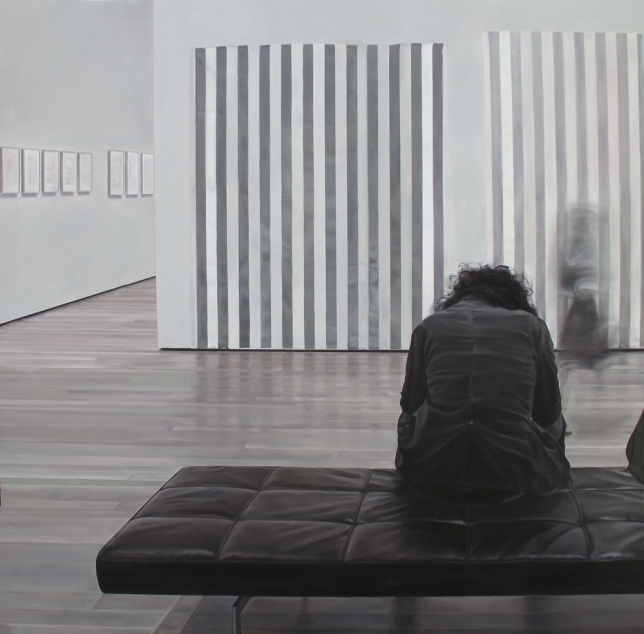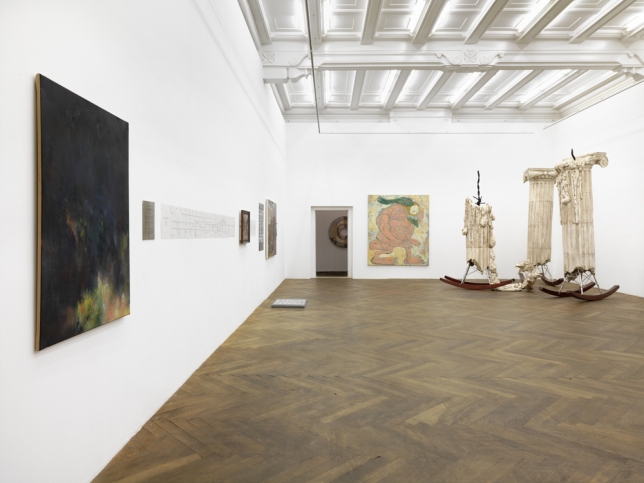Annie Cabigting
Born 1971 in Makati City, Philippines
Lives and works in Quezon City, Philippines
It could be said that the art of Annie Cabigting has always involved painting other people’s artworks. She has, throughout her career, made convincing versions of paintings by Jackson Pollock, Mark Rothko, Chuck Close, and even her Filipino colleague Louie Cordero (My Grotesque, 2011), to name but a few, all appearing within the frame of her canvas as part of the composition. Considering her methods, one can just imagine the string of questions arising over notions of authorship, appropriation, reproduction, and—even, to a point—imitation, which perhaps begs the question, “Can other works of art be treated as subject matter?”
The whole history of art, including current artworks of both famous painters and colleagues, can inspire artists; but Cabigting brings an oblique slant to the art world’s ongoing antiphon by treating iconic pieces as items that have become part of our visual and mental landscape. They have become an inevitable part of the mise-en-scene in the locations she has chosen to paint: museums and galleries. Her works explore the idea of appropriation in order to investigate the aura that is inherent in art objects. Her way of reflecting on the traditions of both looking at and presenting works of art is linked to Western practices of institutional critique which developed in the 1970s in close proximity to feminist practices, such as the works of Louise Lawler.
Whether selecting subject matter that is situated in galleries, museums, or auction houses, drawn from books, or rooted in the peculiar appearances of the objects themselves, Annie Cabigting does not stray far from the world that already contains them.
She depicts the whole spectrum of activities— from looking at a piece of art, trading it, publishing, presenting or archiving it—and deconstructs the range of meanings that we attach to it.
CV
Education
1994 Graduated with Major in Painting, University of the Philippines
Diliman, Quezon City, Philippines
Selected Solo Exhibitions
2014 The Lights Going On and Off, MO_Space, Taguig City, Philippines
2013 There’s always something to look at if you open your eyes!, Richard Koh Fine Art, Artspace, Singapore
2012 Black and white under a shroud of grey and gray, Finale Art File, Makati City, Philippines
Under Wraps, Silverlens, Makati City, Philippines
Dietro Mona Lisa, West Gallery, Quezon City, Philippines
2011 Eccentric Windows, Richard Koh Fine Art, Kuala Lumpur, Malaysia
2010 title withheld (three paintings), Finale Art File, Makati City, Philippines
Mutating Truths, Artesan Gallery + Studio, Singapore
2009 Pictures of Pictures, Finale Art File, Makati City, Philippines
2007 Something to Do with Art, Finale Art File, Makati City, Philippines
2006 Hanging Paintings, Finale Art Gallery, Mandaluyong City, Philippines
2005 100 Pieces, Finale Art Gallery, Mandaluyong City, Philippines
Selected Group Exhibitions
2015 Stick Up Don’t Move Smile, Finale Art File, Makati City, Philippines
2014 Do You Believe in Angels, MO_ Space, Taguig City, Philippines
2013 Ateneo Art Awards 2004–2013: A Retrospective, Ateneo Art Gallery, Quezon City, Philippines
I Love Painting and Painting Loves Me, Finale Art File, Makati City, Philippines
Closed Door Meeting, Finale Art File, Makati City, Philippines
The Mona Lisa Project, West Gallery, Quezon City, and Cultural Center of the Philippines, Pasay City, Philippines
2010 Latitudes. Encounters with the Philippines, Primo Marella Gallery, Milan, Italy
2009 Selected Memory, Richard Koh Fine Art, Kuala Lumpur, Malaysia 4th Prague Biennale, Czech Republic
Post-Tsunami Art: South East B(l)ooming, Primo Marella Gallery, Milan, Italy
2008 Young Contemporary Philippines I, Richard Koh Fine Art, Kuala Lumpur, Malaysia
2006 Girls Will Not Be Girls, Art Center – SM Megamall, Mandaluyong City, Philippines
2004 Bread and Butter Machine, West Gallery, Makati City, Philippines
The Sedimentation of the Mind is a Jumbled Museum, UP Vargas Museum, Quezon City, Philippines
Cancelled Metaphor II, Art Center– SM Megamall, Mandaluyong City, Philippines
2002 Reflecting Skin, Pinto Art Museum, Antipolo City, Philippines
2001 The Paint Thing, West Gallery, Makati City, Philippines
 Annie Cabigting, MOMA, 2015, oil on canvas, 152,4 × 152,4 cm, CABI0003
Annie Cabigting, MOMA, 2015, oil on canvas, 152,4 × 152,4 cm, CABI0003
Exhibitions
A3 PRESENTS: WASAK! Filipino Art Today
December 8, 2015 – January 30, 2016
Opening | Saturday | December 5, 2015, 12 - 6 pm
A group exhibition curated by Norman Crisologo and Erwin Romulo across two locations in Berlin at:
ARNDT Berlin Potsdamer Strasse 96 (Tue - Sat, 11am - 6pm)
ARNDT ART AGENCY A3 Fasanenstrasse 28 NEW PREMISES (Wed - Sat, 12 - 6pm)
Exhibiting artists: Zean Cabangis, Annie Cabigting, Buen Calubayan, Louie Cordero, Jigger Cruz, Marina Cruz, Kawayan De Guia, Alfredo Esquillo, Ian Fabro, Nona Garcia, Robert Langenegger, Pow Martinez, Manuel Ocampo, Alwin Reamillo, Norberto Roldan, Kaloy Sanchez, José Santos III, Rodel Tapaya, Tatong Torres and Ronald Ventura.
A publication has been published by DISTANZ Verlag to accompany the exhibition.
View the complete publication HERE.
The underlying motivation of the exhibition and accompanying publication in Berlin is to shed light on the fascinating contemporary art landscape in the Philippines. WASAK! explores Filipino contemporary art, in the hope of providing an emblematic contextual compendium for western audiences. Signaling the first instance of its kind, WASAK! thus offers snapshots of current artistic practices from the Philippines, uniting a selection of its leading protagonists across generational lines, genres, and media.
All of the 19 participating artists included have witnessed the social and political upheaval of Philippines’ recent history. Most of these artists spent their maturation grappling with local events that have transpired such as: natural disasters like earthquakes and floods; political unrest in the form of coup d’état and calls to presidential impeachments; political ineptitude in the form of corruption and briberies; and longstanding bouts with poverty and urban overpopulation. This selection of artists have nurtured, or at least, directed their ideas into the reality that is Manila, the nation’s capital, from where most of the country’s bizarre undulations spring.
Although much of their work is inspired by their own localities, these artists continue to seek their place among the rest of the world. Through the jumble and mess of their own ground zero—which is a country of broken histories, a nation of lush influences, and a people constantly having to live despite of something—their art continued to become, individually, more diverse and yet collectively, as a single exploded view. ‘Wasak’ is a Filipino word that means “in ruins.” When used in the vernacular, it means “wrecked,” or as a more encouraging interjection—it can also mean “going for broke.” It is a term that signals a hazard.
In this field of scattered landscapes, of broken narratives and loose continuity, what then could be ascribed as Philippine Art? The artists represented in WASAK! have come from the different potholes this gap has created, which explains the varying degrees how their work tries to explain not only a locality, but their own place in art history.
In a 1979 essay, one of the most influential Filipino art critic, Leo Benesa, asked the question: “What is Philippine in Philippine Art?” Knowing how any kind of art from any other place cannot escape the influence of the Western canon, he settled with a more optimistic response in implying that the intention of the artist to paint well is what makes them Filipino: “Painters first, and bearers of message, second,” he concluded. The majority of the artists in the show have chosen painting as their primary medium, with a few exceptions that have dealt primarily with assemblage and sculpture. In looking at their paintings, trying to find out what special place they hold, we can follow Benesa’s prescription—to look at the form first, and then deal with the message later. To try to understand, before anything else, that their intention is to do something which is relevant for them, before handing out a prognosis that casts them as representatives of an aesthetic sensibility, a socio-historical period, or worse, a movement.
The 19 artists covered in WASAK! provide us with an opportunity to experience the different directions they have wandered into—a chance to view a small course of history that is finding its way into the arts.
ARNDT Berlin
Potsdamer Strasse 96
10785 Berlin
info@arndtberlin.com
+49 30 2061 3870
ARNDT ART AGENCY A3
Fasanenstrasse 28
10719 Berlin
contact@arndtartagency.com
+49 30 2061 3870
PRESS
Randian | WASAK! | 7 April, 2016
Coconuts Manila | There’s an exhibit of PH contemporary art in Berlin and it’s called…'Wasak' | 15 January 2016
Zitty Berlin | „Wasak!“ zeigt Bilder aus einem katholischen Asien | 14 January 2016
Art Radar | WASAK! Filipino Art Today at ARNDT Berlin | 12 January 2016
Kunst und Film | WASAK! Filipino Art Today | January 2016
Artsy | ARNDT Explores the Complexities of Filipino Art in New Berlin Gallery Space | 12 January 2016
Financial Times | The Art Market: All about agencies | 18 December 2015
Blouin artinfo | ARNDT Opens new Berlin Venue With Filipino Art Shows | 11 December 2015
Taz | Kunstraum | Land der Brüche - Kunst aus den Philippinen | 10 December 2015
Artnet | Arndt Gallery Opens New Upmarket Location in West Berlin | 3 December 2015
Inquirer | Filipino Art Exhibit WASAK! to open new gallery in Berlin | 26 November 2015
 Installation view, WASAK! Filipino Art Today, ARNDT Berlin, 2015
Installation view, WASAK! Filipino Art Today, ARNDT Berlin, 2015
 Installation view, WASAK! Filipino Art Today, ARNDT Berlin, 2015
Installation view, WASAK! Filipino Art Today, ARNDT Berlin, 2015
 Installation view, WASAK! Filipino Art Today, ARNDT Berlin, 2015
Installation view, WASAK! Filipino Art Today, ARNDT Berlin, 2015
 Installation view, WASAK! Filipino Art Today, ARNDT Berlin, 2015
Installation view, WASAK! Filipino Art Today, ARNDT Berlin, 2015
 Installation view, WASAK! Filipino Art Today, ARNDT Berlin, 2015
Installation view, WASAK! Filipino Art Today, ARNDT Berlin, 2015
 Installation view, WASAK! Filipino Art Today, ARNDT Berlin, 2015
Installation view, WASAK! Filipino Art Today, ARNDT Berlin, 2015
 Installation view, WASAK! Filipino Art Today, ARNDT Berlin, 2015
Installation view, WASAK! Filipino Art Today, ARNDT Berlin, 2015
 Installation view, WASAK! Filipino Art Today, ARNDT ART AGENCY (A3), 2015
Installation view, WASAK! Filipino Art Today, ARNDT ART AGENCY (A3), 2015
 Installation view, WASAK! Filipino Art Today, ARNDT ART AGENCY (A3), 2015
Installation view, WASAK! Filipino Art Today, ARNDT ART AGENCY (A3), 2015
 Installation view, WASAK! Filipino Art Today, ARNDT ART AGENCY (A3), 2015
Installation view, WASAK! Filipino Art Today, ARNDT ART AGENCY (A3), 2015
 Installation view, WASAK! Filipino Art Today, ARNDT ART AGENCY (A3), 2015
Installation view, WASAK! Filipino Art Today, ARNDT ART AGENCY (A3), 2015
 Installation view, WASAK! Filipino Art Today, ARNDT ART AGENCY (A3), 2015
Installation view, WASAK! Filipino Art Today, ARNDT ART AGENCY (A3), 2015
 Installation view, WASAK! Filipino Art Today, ARNDT ART AGENCY (A3), 2015
Installation view, WASAK! Filipino Art Today, ARNDT ART AGENCY (A3), 2015













